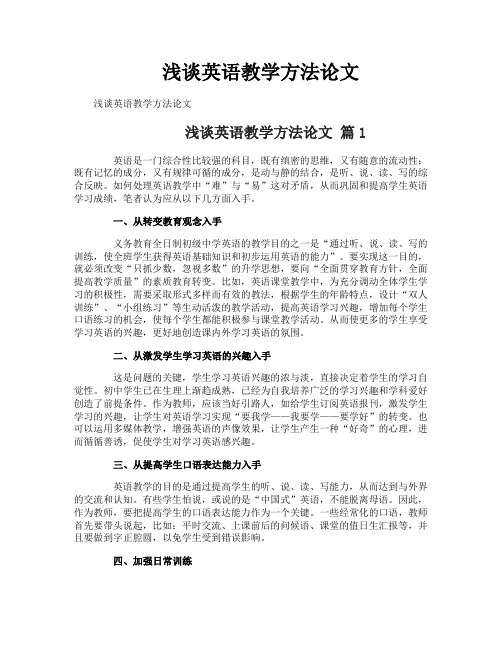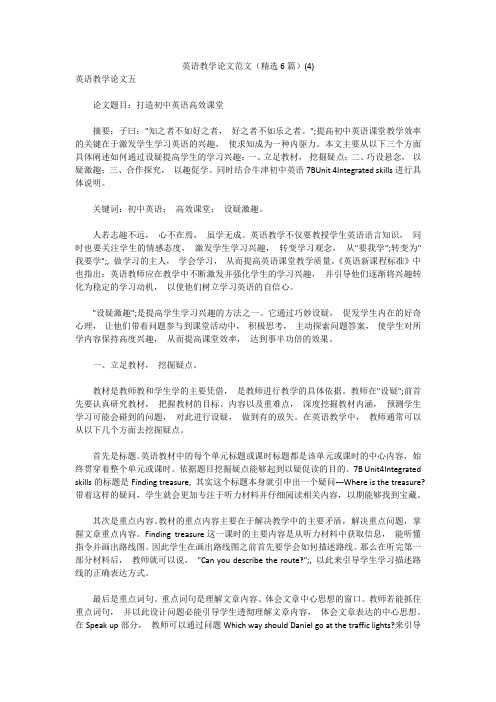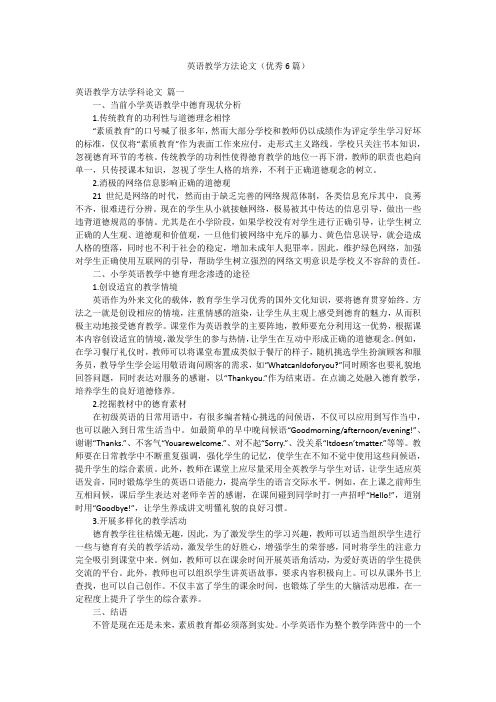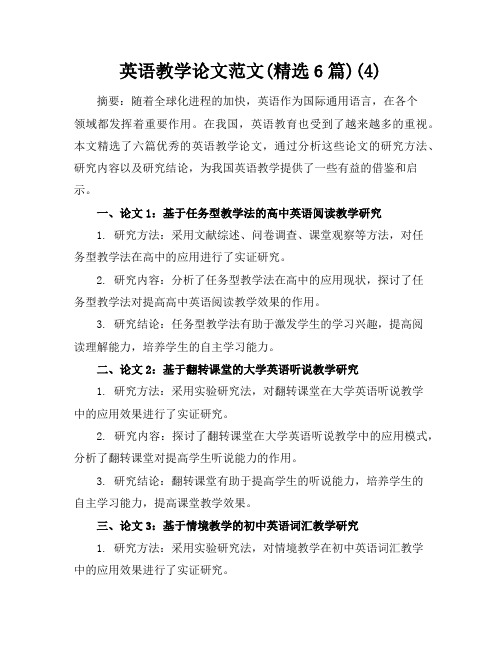英语教学法期末论文
中学英语教学论文优秀6篇

中学英语教学论文优秀6篇浅谈中学英语教学论文篇一[论文关键词]中学英语教学教学和谐统一律三序和谐统一律知识与智力[论文摘要]教学是师生共同的双边活动,掌握运用教、学和谐统一规律,充分发挥教、学两个积极性;将教材学科体系知识结构的序、学生认识规律的序和教学结构程序三序统一,循序渐进,教学才能高质量高效率;教思路、教方法,进一步培养学生的能力、发展学生的智力、开发学生的创造力,使学生的知识和智力相互促进,协调发展。
笔者通过对《中学英语教学法》和《英语新课程标准》的进一步学习和研究,以及几年的中学英语教学实践,从理论和实践两个方面,探索出如下一些中学英语教学规律,供同仁们参考,如有不妥之处,请批评指正。
一、教学和谐统一律教学是师生共同的双边活动,教学中,教是为了学,受制约于学;学需要教,受指导于教。
教和学相辅相成,缺一都构不成教学过程的额有机整体,都不能圆满完成教学任务。
所以,教、学和谐统一是教学过程的一条基本规律,它是对立统一的规律在英语教学关系上的体现。
英语课是一门实践性很强的语言技能课程。
至少在最初阶段,教英语不像教学历史或化学那样主要是由教师把知识传授给学生。
英语教学中当然有该学到的知识,如语言学、音位学等知识,但这些并不是我们在教学初期阶段所要教给学生的。
同样,对于英语教学,毫无疑问,模仿是成功的钥匙之一。
语言学习在很大程度上取决于听准教师发音的能力,取决于准确模仿教师语音的技能,取决于反复练习同样的语音和句型的耐心和恒心,取决于掌握它们的牢固的记忆力。
当然,这首先要求教师要有良好的精神风貌、较高的业务水平和教学艺术,因为这些对学生的学习信念,学习习惯和学习质量起着重要的作用,直接影响到英语教学的质量。
既然英语课是一门实践性很强的课程,那么,无论是语言知识还是言语技能,都要靠学生自己学得主动、练得积极才能有所长进,教师只能主导而不能包办代替。
“君子之教,喻也。
道而弗牵,强而弗抑,开而弗达。
道而弗牵则和,强而弗抑则易,开而弗则思。
大学英语专业《教学法》论文

《教学法》期末论文My Teaching Philosophy II have a dream that one day I can be a teacher. During my college life, I have tutored some kids. And I also have taught pupils as a volunteer. In addition, this term, we learned A Course in English Language Teaching. Therefore, I have my own understanding about teaching philosophy by combining theory with practice.1.The role of a teacherK. Patricia Cross has said, “The task of the excellent teacher is to stimulate …apparently ordinary‟ people to unusual effort. The tough problem is not in identifying win ner: it is in making winner out of ordinary people.” I totally agree with the quote. A teacher is the one who shapes the personality and entire life of children. It is one of the noble professions as it contributes in building the future of the country and overall society. Teachers play a significant and a valuable role as they influence the lives of children who are the future of tomorrow.2. My understanding of good teachingWhen you strive and work to become a good teacher and to create a good class, the following four “Core qualities” are the essential, the skills to convey that knowledge, the ability to make the material you are teaching interesting and relevant, and a deep-seated respect for the student. The first is knowledge, in every survey, students consistently and clearly target as the number one quality of a good teacher exactly what you would expert: knowledge of the subject. You must be an expert in your field. This is a prerequisite. The second core quality is the ability to communicate their knowledge and experience to their students. Give your students an answer and they can solve one problem, but show them the techniques needed to find the answer for themselves and they can become self-sufficient in the field. Students need to show how to apply the new techniques you teach to problems solving. A good teacher starts with a firm knowledge of the subject, and builds on that with a clarity and understanding designed to help students master the material. Good teachers work hard to make their material relevant. They show students how the material will apply to their lives and their careers. And the last one is respect. The creation of a good class requires an immense amount of work. You spend time with your students so you canlearn about holes in their understanding. You read and write and create to build an exciting and interesting class every day. The only thing that would drive you to do that is a concern and respect for the adults in your classroom.3.The ways to correct errorsThere are different ways and techniques for correcting errors, such as direct teacher correction, indirect teacher correction, self-correction, peer correction, whole class correction, etc. As a general rule, indirect teacher correction is encouraged rather than d irect teacher correction to avoid damaging students‟ self esteem and confidence. Indirect techniques include‟ repeating the problem sentence with an emphasis on the problem in a rising tone‟, …asking a question to invite the students to say it again with a hint of a problem‟, …a simple repetition of a correct sentence as a model‟, and …using facial expression or gesture to indicate a problem‟, etc. In practice, self-correction is encouraged before teacher correction or peer correction because if it is a mistake, the student himself/herself will be able to correct it. If the student cannot self-correct, it means there is a lack of competence and the teacher can help with the correction or may ask other students to help correct it. Sometimes, the whole class can be divided to correct as well. For example, you can select the main error types. Write four or five on the blackboard. Put students in pairs for a few minutes to discuss and correct the errors. Then the whole class can do the correction together. The focus can be choice of vocabulary, use of grammar, or pronunciation. With higher lever learners you can also focus appropriate context.4. Motivating students to succeedMotivational speakers inspire all of us. You can take a few tips from them in your own teaching. Put positive mottos or inspirational statements on your syllabus and communicate them to the students in class. Encourage our students to want to excel in your class by helping them to do more than they thought they could.When you describe the goals of the course, do so with enthusiasm. do so with enthusiasm. Personal connections make a big difference. Try to learn your students' names as quickly as possible, and refer to them by name. If you have a large class or if you are notMy Teaching Philosophy IIIn my first draft, I introduced my own understanding about teaching philosophy by combining theory with practice. Now, in the second draft, I will focus on what I will do if I am given a chance to conduct a course in the middle school in the future.How to conduct a course in the middle school1.The context of the courseMy learners will be the middle school students. They have already have had one previous experience of English learning with a basic knowledge. Chinese education system is examination-oriented education. Meanwhile, China‟s educational system determines some learners‟ motivation of learning English-passing examination. Therefore, in the middle school, usually they show great interest in English at the beginning of learning, which may be due to their curiosity and the novelty of English. But with the development of study, their interest decreases and even disappears. The teachers use the same and boring teaching model. And the students have to memory words, phrases, and sentences for examination. In the class, they have no question but only take notes. And in this day and age, English plays more and more important role in China. And our country pays more and more attention to English. This class, I will teach unit 2 which about something about illness, healthy.2.Course aims and objectivesMy course is to describe the knowledge, skills, methods, value of the course by using specific, clear and operational behavior language.Objectives: By the end of the session, most students will be better able to acquire information. This will be achieved by:⑴ . Knowledge Objectives:①Be able to master the pronunciation, meaning and spelling of the name of diseases: fever, sore throat, sore back, stomachache, headache, toothache, cold, cough;② Be able to learn the expression of giving advice: lie down and rest, drink hot tea with honey, see a dentist, take this medicine;③Be able to talk about health problems by using “what is the matter? I havea …” and give advice by using “you should… you should not…”⑵. Ability Objectives:① Be able to talk about one‟s health problems and give advice fluently;② Be able to role play doctor and patient.⑶ Moral Objectives:① Improve the cooperative spirit through pair work and role playing;②Care more about yourself and your family members‟ health.3.Teaching ProceduresStep 1: Warming upGreet Ss by asking them: How are you today? Then I will tell Ss that I am not feeling well today (Write the sentence on the blackboard and guide Ss to read it.) and get Ss to guess the reason freely. If Ss cannot get the answer, I will tell them that I did not have a good sleep last night. So I have a headache. (I say this by doing a gesture) Step 2: Presentation of words about diseases⑴ Show Ss a bandage and tell them there is something wrong in the place where the bandage lies. Then get Ss to guess the health problems. When I do an action, ask Ss: “What‟s the matter?”(write it on the blackboard) For example, when I put the bandage on the stomach, ask Ss: “What‟s the matter with me?” Help Ss say: “I‟m not feeling well. I have a stomachache.” Then teach the other target words: fever, sore throat, toothache, sore back in the following way: Put the bandage on the other part of body and get students to ask: What‟s the matter? Then get other Ss to guess the problem.⑵ Use body language to guide Ss to guess another two names of diseases: cold, cough.⑶ Show Ss pictures of diseases half hidden, and get Ss to guess the names of diseases: fever, sore throat, toothache, sore back, cold, cough.Step 3: Pair workPut the bandage on the part of a student‟s body and ask: “What‟s matter?” andguide him to use t he pattern: I‟m not feeling well. I have a… Then ask Ss to work in pairs and talk about health problems by using the bandage given and using the target language: What‟s the matter? I‟m not feeling well. I have a …Step 4: Presentation of expressions of giving advice⑴ Tell Ss that I have a cold/cough, ask them: What should I do? Ss may give different answers, collect their answers and help them to use: You should/shouldn‟t do… Then show some pictures of other diseases mentioned before and ask them to give advice to each problem by using target language: You should/shouldn‟t do… During this activity, some phrases will be learned: lie down and rest, drink hot tea with honey, see a dentist, drink lots of water, take some medicine.⑵ Show Ss two bags. In one bag, there are pieces of paper with problems while in the other one, there are pieces of paper with advice. Have a competition between boys and girls. Take turns to get paper. For example, one boy gets one paper with problem, and one girl get one paper with advice. The girl should say: What‟s the matter with you? The boy should answer the question according to the problem he got by saying: I‟m not feeling well. I have a…If the girl got the right advice, she should answer it accord ing to her paper: You should… If it is not, she should say: You shouldn‟t, then give the right advice. The one who makes right sentence can get one point.Step 6: Role playingAsk Ss to make a four -people group, one of them is a doctor, the other three are patients. Ask the Ss to role play the dialogue above. Then ask several groups to perform before the class by using some tools: bandage, a uniform, a stethoscope. Ask other Ss to select the best doctor and the best patient.。
英语英语教学工作总结论文8篇

英语英语教学工作总结论文8篇篇1引言英语教育是培养国际化人才的重要途径,而英语教学的质量直接影响到学生的语言水平和国际竞争力。
本文将对过去一年英语教师的教学工作进行总结,分析教学方法、教学效果以及存在的问题,并提出改进措施,以提升英语教学质量。
一、教学工作总结1. 教学目标与内容在过去一年中,英语教师主要围绕听说读写四个方面展开教学,旨在提高学生的语言综合运用能力。
教学内容包括单词、语法、句型、阅读和写作等,同时结合实际生活场景进行模拟练习,增强学生的语言实践能力。
2. 教学方法与手段在教学方法上,英语教师采用了多种形式,如讲解、示范、互动讨论、角色扮演等,以激发学生的学习兴趣和积极性。
同时,教师还运用了多媒体手段,如PPT、视频、音频等,丰富教学内容,提高教学效果。
3. 教学评价与反馈在教学评价方面,英语教师主要通过课堂表现、作业完成情况、口语测试和笔试成绩等方面对学生进行评估。
同时,教师还注重学生的反馈意见,及时调整教学方法和手段,以提高教学质量。
二、教学效果分析通过一年的教学工作,学生的语言水平得到了显著提高。
在听说方面,学生能够流利地进行日常对话,语音语调自然,表达清晰。
在读写方面,学生的阅读速度和理解能力有所提升,写作水平也有所提高。
此外,学生在国际比赛中也取得了优异成绩,为学校争得了荣誉。
三、存在的问题与改进措施尽管英语教学质量有了显著提高,但仍存在一些问题需要改进。
首先,部分学生在学习过程中存在焦虑情绪,影响学习效果。
针对这一问题,教师可以采用心理辅导和激励措施帮助学生缓解焦虑情绪。
其次,部分学生的口语水平仍有待提高。
针对这一问题,教师可以增加口语练习的频率和难度,同时鼓励学生多参与课堂讨论和角色扮演等活动。
最后,部分学生的学习方法有待改进。
针对这一问题,教师可以指导学生制定合理的学习计划,掌握有效的学习策略和方法。
四、结论与展望通过对过去一年英语教师教学工作的总结和分析,我们可以看到英语教学质量取得了显著成果。
英语教学方法探析论文9篇【论文】

英语教学方法探析论文9篇第一篇:职高英语教学方法刍议一、加强说、写训练,培养学生运用语言的能力英语是一门实践性很强的课程,课堂上除了讲必要的语音、词汇、语法等基础知识外,更重要的是指导学生进行说、写训练,以培养学生运用语言的能力。
那么,如何做到这一点呢?1.用学过的知识进行有情景的对话,表演节目,做游戏。
如教师说一个单词,学生以单词的最后一个字母为第一个字母说一个单词,其余学生以此类推。
这叫“首尾相接记词法”。
还可以是教师做动作或让学生互相做。
总之,要多采用形象直观的教学手段,使学生学得轻松愉快。
这种寓知识于娱乐之中的做法,把学生的注意力吸引到教学中,活跃了课堂气氛,有利于提高英语课堂教学效果。
2.每学期在同年级或同班举行一次班与班、组与组的课外活动,举办一次英语学习园地,让学生用英语写谜语,缩写课文,介绍家庭情况、班级情况,介绍学习经验,抄写幽默、笑话等。
培养学生的运用能力最关键的是培养学生的“开口”能力,要求学生多说英语,不仅在课堂而且在课外都要说,营造学英语的环境和氛围。
在英语教学中,听、说、读、写这四个环节是相辅相成的,忽视哪一方面都不利于提高英语教学质量,要坚决纠正不动口、不动手的坏习惯。
二、教学生一本两用,培养学生的综合能力要求学生备一个较厚的笔记本,从前往后记教师讲的要点及纠正经常出现的错误等。
从后往前记词语,每上完一节课要求学生把重要的词语记下来,把不懂的内容记下来,把难理解的词汇记下来。
这样既可以培养学生自觉整理知识的能力,又方便复习之用。
三年坚持下来,效果非常显著。
三、改革课堂结构课堂教学结构实质上就是教学步骤。
它是由教学思想、教学目的所决定并为之服务的。
课堂教学结构安排不当就很难完成教学任务。
课堂教学结构虽无固定的模式,但要遵循学习书本知识的规律,即“感知—理解—记忆—应用”,因人、因材、因时采用预习课文“发现问题—解决问题—巩固提高”的教学结构,或采用“导入新课—讲解新知识—应用新知识”三环节的教学结构为好。
大学英语教学论文(9篇)_英语论文

大学英语教学论文(9篇)_英语论文第一篇:独立学院大学英语教学ESP理论应用一、引言独立学院以培养符合社会和市场需求的应用型人才为目标,在我国高等教育大众化发展现阶段,独立学院面临着空前挑战和激烈竞争。
大学英语是规模最大的基础课程,近年来各独立学院纷纷进行大学英语改革,如分级教学、模块教学、翻转课堂等。
改革在一定程度上提高了学生的英语水平,但目前独立学院大学英语以一般用途英语(EnglishforGeneralPur-pose)为主,虽然强调提高学生听、说、读、写、译技能,但实际上主要目标是提高学生的应试能力,尤其是通过全国大学英语四六级考试的能力。
因此,不足以满足学生毕业后对英语的日常和工作需求,未能很好地实现独立学院培养应用型人才这一目标。
专门用途英语,即ESP(EnglishforSpecificPurposes),是近年来外语教育界研究的热点之一,尤其受到独立学院英语教师们的关注。
在EGP的基础上,ESP不但适合我国现阶段英语教学发展要求,而且将英语教学和学生将来职业发展联系起来,针对性强,符合独立学院应用型人才培养目标。
二、ESP简介ESP产生于二战后,许多国家正重振经济、发展科技、加强国际间交流。
英语已被认为是科技和商贸领域里的国际语言,因此,人们学习英语的目的十分明确,即掌握英语为自己所从事的专业服务。
随着社会发展,ESP成为社会语言学关于变体理论、功能分类理论、语域理论在外语教学中的具体运用。
在大学英语教学中,和EGP不同,ESP是为了满足学习者特定的学习要求而与某种特定职业或学科相关的英语学习。
除了基本的语言技能之外,在内容方面与特定职业或专业相关,更具有专业内涵性和实际应用性,如旅游英语、商务英语、法律英语、计算机英语等。
因此,EGP教授的是英语语言的普遍现象,而ESP是以EGP为基础,在EGP 的基础上不同专业的变体,是EGP发展的高级阶段。
三、ESP理论在独立学院中的应用分析(一)学生分析因定位和自身特点,独立学院生源质量与普通高校相比存在一定的差距。
浅谈英语教学方法论文

浅谈英语教学方法论文浅谈英语教学方法论文浅谈英语教学方法论文篇1英语是一门综合性比较强的科目,既有缜密的思维,又有随意的流动性;既有记忆的成分,又有规律可循的成分,是动与静的结合,是听、说、读、写的综合反映。
如何处理英语教学中“难”与“易”这对矛盾,从而巩固和提高学生英语学习成绩,笔者认为应从以下几方面入手。
一、从转变教育观念入手义务教育全日制初级中学英语的教学目的之一是“通过听、说、读、写的训练,使全班学生获得英语基础知识和初步运用英语的能力”。
要实现这一目的,就必须改变“只抓少数,忽视多数”的升学思想,要向“全面贯穿教育方针,全面提高教学质量”的素质教育转变。
比如,英语课堂教学中,为充分调动全体学生学习的积极性,需要采取形式多样而有效的教法,根据学生的年龄特点,设计“双人训练”、“小组练习”等生动活泼的教学活动,提高英语学习兴趣,增加每个学生口语练习的机会,使每个学生都能积极参与课堂教学活动。
从而使更多的学生享受学习英语的兴趣,更好地创造课内外学习英语的氛围。
二、从激发学生学习英语的兴趣入手这是问题的关键,学生学习英语兴趣的浓与淡,直接决定着学生的学习自觉性。
初中学生已在生理上渐趋成熟,已经为自我培养广泛的学习兴趣和学科爱好创造了前提条件。
作为教师,应该当好引路人,如给学生订阅英语报刊,激发学生学习的兴趣,让学生对英语学习实现“要我学——我要学——要学好”的转变。
也可以运用多媒体教学,增强英语的声像效果,让学生产生一种“好奇”的心理,进而循循善诱,促使学生对学习英语感兴趣。
三、从提高学生口语表达能力入手英语教学的目的是通过提高学生的听、说、读、写能力,从而达到与外界的交流和认知。
有些学生怕说,或说的是“中国式”英语,不能脱离母语。
因此,作为教师,要把提高学生的口语表达能力作为一个关键。
一些经常化的口语,教师首先要带头说起,比如:平时交流、上课前后的问候语、课堂的值日生汇报等,并且要做到字正腔圆,以免学生受到错误影响。
初中英语教学优秀论文3篇

初中英语教学优秀论文3篇
论文1:提高初中英语教学质量的有效策略
这篇论文探讨了提高初中英语教学质量的有效策略。
作者首先分析了初中英语教学存在的问题,如学生研究动力不足、教材内容单一等。
接着,作者提出了一些行之有效的策略,包括鼓励互动式研究、提供个性化辅导等。
最后,作者通过实践案例证明了这些策略的有效性。
论文2:提高初中英语口语能力的教学方法研究
本文旨在研究提高初中学生英语口语能力的教学方法。
作者通过对现有教学方法的分析和评估,提出了一种以情景教学为基础的方法。
该方法通过创造真实的语境,促使学生主动参与口语表达。
实证研究表明,该方法可以有效提高学生的口语能力。
论文3:初中英语课堂互动教学的实施策略
这篇论文介绍了初中英语课堂互动教学的实施策略。
作者提出了一套可行的策略,包括采用小组活动、引入多媒体资源等。
通过实际教学案例的分析,作者证明了这些策略能够激发学生的研究兴趣,提高课堂互动效果。
以上是三篇关于初中英语教学的优秀论文的简要介绍,希望对您有所帮助。
如需详细内容,请查阅相关文献。
英语教学论文范文(精选6篇)(4)

英语教学论文范文(精选6篇)(4)英语教学论文五论文题目:打造初中英语高效课堂摘要:子曰:"知之者不如好之者,好之者不如乐之者。
";提高初中英语课堂教学效率的关键在于激发学生学习英语的兴趣,使求知成为一种内驱力。
本文主要从以下三个方面具体阐述如何通过设疑提高学生的学习兴趣:一、立足教材,挖掘疑点;二、巧设悬念,以疑激趣;三、合作探究,以趣促学。
同时结合牛津初中英语7BUnit 4Integrated skills进行具体说明。
关键词:初中英语;高效课堂;设疑激趣。
人若志趣不远,心不在焉,虽学无成。
英语教学不仅要教授学生英语语言知识,同时也要关注学生的情感态度,激发学生学习兴趣,转变学习观念,从"要我学";转变为"我要学";, 做学习的主人,学会学习,从而提高英语课堂教学质量。
《英语新课程标准》中也指出:英语教师应在教学中不断激发并强化学生的学习兴趣,并引导他们逐渐将兴趣转化为稳定的学习动机,以使他们树立学习英语的自信心。
"设疑激趣";是提高学生学习兴趣的方法之一。
它通过巧妙设疑,促发学生内在的好奇心理,让他们带着问题参与到课堂活动中,积极思考,主动探索问题答案,使学生对所学内容保持高度兴趣,从而提高课堂效率,达到事半功倍的效果。
一、立足教材,挖掘疑点。
教材是教师教和学生学的主要凭借,是教师进行教学的具体依据。
教师在"设疑";前首先要认真研究教材,把握教材的目标、内容以及重难点,深度挖掘教材内涵,预测学生学习可能会碰到的问题,对此进行设疑,做到有的放矢。
在英语教学中,教师通常可以从以下几个方面去挖掘疑点。
首先是标题。
英语教材中的每个单元标题或课时标题都是该单元或课时的中心内容,始终贯穿着整个单元或课时。
依据题目挖掘疑点能够起到以疑促读的目的。
7B Unit4Integrated skills的标题是Finding treasure, 其实这个标题本身就引申出一个疑问---Where is the treasure?带着这样的疑问,学生就会更加专注于听力材料并仔细阅读相关内容,以期能够找到宝藏。
优秀小学英语教学论文(通用8篇)

优秀小学英语教学论文(通用8篇)优秀小学英语教学论文(通用8篇)在学习和工作的日常里,大家最不陌生的就是论文了吧,论文一般由题名、作者、摘要、关键词、正文、参考文献和附录等部分组成。
那么问题来了,到底应如何写一篇优秀的论文呢?以下是小编帮大家整理的优秀小学英语教学论文,仅供参考,希望能够帮助到大家。
优秀小学英语教学论文篇1摘要:教学作为我们的本职工作,要想做好做精彩,我认为是一件极富挑战的事情。
对于新课改的推广,我们面临角色的转变,所以要成为一名合格的好老师不是一件容易的事情。
我们必须不断地充实自己,为提高小学生的英语素质和语感做好必要的学习和准备。
关键词:小学英语;教学一个合格的英语老师不仅要有良好的英语语感和纯正的英语发音,同时还要能够在英语教学中调动学生学习英语的积极性。
英语教师必须要了解小学生,了解他们学习的兴趣点在哪里,了解他们这个年龄段的喜好在哪里,并根据这些来改变我们相应的教学模式和教学方法。
总之,一个能够让小学生满意的英语教师一定能够和学生“打”成一片,能够做学生喜欢做的事,和学生做知心朋友,以调动学生对英语学习的参与度,改变我们多年的哑巴英语和聋子听力的教学局面。
下面是笔者结合自己多年的教学经验,谈谈对小学英语教学的一些看法,有不妥的地方,欢迎各位同仁批评指正。
第一,缺乏英语学习的环境。
我们都知道,如果想学好一门语言,最重要的就是语言环境的建立。
然而,就我们目前的实际情况来说,要想为学生创建一个纯英语的环境,还存在一定的差距。
比如来自英语教师对英语实际的应用水平、口语能力、教学能力等,还有上课的时间等。
我们的小学生接触英语的时间一个星期下来非常有限,退一步说,就是我们的英语课堂使用了纯英语教学,同时还配备了各种有助于学生理解英语的教学教具,但是课堂教学实践毕竟太过有限,所以就算学生在课堂上学习再积极,但是下课后也难免会生疏忘记。
学生在课下几乎没有能够说英语的时间,这样的环境几乎是没有的。
英语教学法论文10篇

英语教学法论文10篇无论是在学习还是在工作中,大家都接触过论文吧,借助论文可以有效训练我们运用理论和技能解决实际问题的的能力。
写起论文来就毫无头绪?下面是书包范文为您带来的英语教学法论文10篇,希望能够给朋友们的写作带来一定的启发。
【摘要】随着社会文化学科的不断发展和进步,针对社会文化学的相关研究也不断增多,在社会学领域内的文化学科强调在社会和文化环境下以语言和社会活动作为中介来实现人们对知识的学习,可以看到,英语教学在一定程度上也是社会文化学领域内的一部分,因而本文通过研究英语教学和社会文化学的相关要点明确如何应用社会文化学在实现英语教学。
【关键词】社会文化学;英语教学引言近年来,随着国际间教育领域合作的加强,针对英语语言教学的全新看法颠覆了传统教育学视阙下英语教学作为单一语言教学的观点,而将社会文化属性加诸于英语语言教学。
因而在此一现实环境下,通过全新的教学方法与教学实例来促进英语教学在社会文化要素方面的累积可谓十分重要,社会文化学强调对语言体系的学习过程,同时加重了任务型教学的比例。
这些变化都催生了英语教学的现实进展,同时也为社会文化学视角下的英语教学的研究提供了更多的可能性。
一、英语教学的社会文化学属性二、社会文化学在英语教学中的应用维果斯基的社会文化学在英语教学中的研究与应用已屡见不鲜,比如英国学者Lantolf等人便认为学习者在交际情景中所进行的大部分交际活动都与其自身的需求密切相关,他们使用语言来处理其相应的事务和遭遇。
在国内类似的应用也早有研究可查,主要体现在对我国英语教学体制和英语教学方法的方面,比如修订的英语教学大纲就针对英语教学实际提出了应该完善以英语培养为核心、加强英语语言的应用和基本技能的培养,侧重于学生通过英语的学习可以达成的解决问题的能力而不仅仅是英语学习相关的知识性技能。
近年来,英语教学在英语学习大纲的变化之下也相应的产生了较多变化,比如在实际教学中更加注重结合本土社会文化以及英语语言文化进行教学,注重教学环节的自由、平等,减少填鸭式教学方式的应用,在尊重学生自我学习习惯和自我实践方式的基础上引导性的进行英语教学,在这一过程中减轻了英语教学的固有负担,注重学生的综合能力培养。
英语教学方法论文(优秀6篇)

英语教学方法论文(优秀6篇)英语教学方法学科论文篇一一、当前小学英语教学中德育现状分析1.传统教育的功利性与道德理念相悖“素质教育”的口号喊了很多年,然而大部分学校和教师仍以成绩作为评定学生学习好坏的标准,仅仅将“素质教育”作为表面工作来应付,走形式主义路线。
学校只关注书本知识,忽视德育环节的考核。
传统教学的功利性使得德育教学的地位一再下滑,教师的职责也趋向单一,只传授课本知识,忽视了学生人格的培养,不利于正确道德观念的树立。
2.消极的网络信息影响正确的道德观21世纪是网络的时代,然而由于缺乏完善的网络规范体制,各类信息充斥其中,良莠不齐,很难进行分辨。
现在的学生从小就接触网络,极易被其中传达的信息引导,做出一些违背道德规范的事情。
尤其是在小学阶段,如果学校没有对学生进行正确引导,让学生树立正确的人生观、道德观和价值观,一旦他们被网络中充斥的暴力、黄色信息误导,就会造成人格的堕落,同时也不利于社会的稳定,增加未成年人犯罪率。
因此,维护绿色网络,加强对学生正确使用互联网的引导,帮助学生树立强烈的网络文明意识是学校义不容辞的责任。
二、小学英语教学中德育理念渗透的途径1.创设适宜的教学情境英语作为外来文化的载体,教育学生学习优秀的国外文化知识,要将德育贯穿始终。
方法之一就是创设相应的情境,注重情感的渲染,让学生从主观上感受到德育的魅力,从而积极主动地接受德育教学。
课堂作为英语教学的主要阵地,教师要充分利用这一优势,根据课本内容创设适宜的情境,激发学生的参与热情,让学生在互动中形成正确的道德观念。
例如,在学习餐厅礼仪时,教师可以将课堂布置成类似于餐厅的样子,随机挑选学生扮演顾客和服务员,教导学生学会运用敬语询问顾客的需求,如“WhatcanIdoforyou?”同时顾客也要礼貌地回答问题,同时表达对服务的感谢,以“Thankyou.”作为结束语。
在点滴之处融入德育教学,培养学生的良好道德修养。
2.挖掘教材中的德育素材在初级英语的日常用语中,有很多编者精心挑选的问候语,不仅可以应用到写作当中,也可以融入到日常生活当中。
英语教学的论文

英语教学的论文有关英语教学的论文(精选12篇)在现实的学习、工作中,大家一定都接触过论文吧,论文是一种综合性的文体,通过论文可直接看出一个人的综合能力和专业基础。
那要怎么写好论文呢?以下是小编为大家整理的有关英语教学的论文(精选12篇),供大家参考借鉴,希望可以帮助到有需要的朋友。
英语教学的论文篇1“翻转课堂”(Flipped Class)是以学生自主学习为中心,师生互动学习的一种教学模式,它将微型化、个性化的微课资源有机整合成为我国信息化教学改革的新方向,设计“以学生为主体,微课为基础,课前自学与课上强化为主要形式”的翻转课堂模型。
那么,它在我们的英语教学中如何应用?下面我结合英语教学中比较难处理的阅读教学和语法教学来谈谈翻转课堂的应用。
一、在英语阅读教学中的应用(一)通过课前任务型个性化阅读培养学生自主学习能力课前教师让学生进行自主阅读,学生可以根据自己喜欢的阅读方式进行快乐阅读,让自主学习阅读变成“悦读”。
快乐阅读也应是有目的性的阅读,因此,教师可在课前下发任务单,如让学生根据所读的课文内容自主利用多媒体手段寻找与课文内容有关的视频资料等来辅助阅读内容的理解,自拟几个有关课文内容的问题等,这样既鼓励了学生对语言学习进行独立思考,又培养了学生自主学习的能力。
(二)课堂中开展针对性的阅读指导,让中下等生“吃得饱、消化好”,让优等生“吃得好、营养高”在翻转课堂中,学生已经在课前进行了阅读内容的学习,仍然以圣诞节课文为例,学生在进入课堂学习之前对圣诞节课文的大意已经有所了解,但不同的学生对阅读内容有着不同的疑难问题,因此在课堂中,教师可以通过回收课前下发的任务单并查看学生完成情况的方式发现并帮助学生解决个性化的问题,让中下等生“吃得饱、消化好”,让优等生“吃得好、营养高”,以此加快英语阅读教学课的进程,提升阅读效率。
(三)运用开放性、拓展性的问题机制激活学生个性化的思维,让课堂成为学生展示的主人翻转课堂中的英语阅读教学,首先课前已基本扫清了课文翻译障碍,课堂中教师不必将理解课文大意和知识点的讲解放在首位,所以课堂中的语言学习就应该聚焦于对文章话题的深度讨论和语言点的课外拓展。
英语教学论文范文(精选6篇)(4)

英语教学论文范文(精选6篇)(4)一、任务型教学法在初中英语课堂中的应用研究摘要:随着我国英语教学改革的不断深入,任务型教学法作为一种有效的教学方法,逐渐受到广大英语教师的关注。
本文以初中英语课堂为研究对象,探讨任务型教学法在实践中的应用及其成效。
1. 任务型教学法的概述任务型教学法(Taskbased Language Teaching,简称TBLT)是一种以任务为核心的教学模式,强调学生在完成任务的过程中自然习得语言。
这种教学法主张将语言学习与实际生活相结合,让学生在真实语境中运用英语,提高他们的语言运用能力。
2. 任务型教学法在初中英语课堂的应用实例案例一:《新目标英语》七年级上册Unit 7 “How much are these socks?”(1)任务设计:教师设计了一个“购物”任务,让学生在模拟的购物场景中运用本单元所学词汇和句型进行交流。
(2)任务实施:将学生分成若干小组,每组扮演不同的角色(顾客、售货员等)。
学生在完成任务的过程中,需要运用目标语言进行沟通,达成购物目标。
(3)任务评价:教师根据学生在任务过程中的表现,评价他们的语言运用能力、团队协作能力和问题解决能力。
3. 任务型教学法在初中英语课堂的应用成效(1)提高学生的英语学习兴趣:任务型教学法将课堂知识与实际生活相结合,使学生在轻松愉快的氛围中学习英语,增强了他们的学习兴趣。
(2)培养学生的语言运用能力:通过完成各种任务,学生将所学知识应用于实际情境,提高了他们的英语口语和听力水平。
(3)增进学生之间的合作与交流:任务型教学法强调团队合作,学生在完成任务的过程中,相互帮助、共同进步,增进了彼此间的友谊。
4. 结论任务型教学法在初中英语课堂中的应用具有显著成效,有助于提高学生的英语学习兴趣和语言运用能力。
教师在实际教学中,应根据学生的实际情况和教学内容,灵活设计任务,以充分发挥任务型教学法的优势。
二、任务型教学法在初中英语课堂中的应用策略1. 注重任务的真实性在设计任务时,教师应确保任务的真实性,使其贴近学生的生活实际。
英语教学论文范文(精选6篇)(4)

英语教学论文范文(精选6篇)(4)摘要:随着全球化进程的加快,英语作为国际通用语言,在各个领域都发挥着重要作用。
在我国,英语教育也受到了越来越多的重视。
本文精选了六篇优秀的英语教学论文,通过分析这些论文的研究方法、研究内容以及研究结论,为我国英语教学提供了一些有益的借鉴和启示。
一、论文1:基于任务型教学法的高中英语阅读教学研究1. 研究方法:采用文献综述、问卷调查、课堂观察等方法,对任务型教学法在高中的应用进行了实证研究。
2. 研究内容:分析了任务型教学法在高中的应用现状,探讨了任务型教学法对提高高中英语阅读教学效果的作用。
3. 研究结论:任务型教学法有助于激发学生的学习兴趣,提高阅读理解能力,培养学生的自主学习能力。
二、论文2:基于翻转课堂的大学英语听说教学研究1. 研究方法:采用实验研究法,对翻转课堂在大学英语听说教学中的应用效果进行了实证研究。
2. 研究内容:探讨了翻转课堂在大学英语听说教学中的应用模式,分析了翻转课堂对提高学生听说能力的作用。
3. 研究结论:翻转课堂有助于提高学生的听说能力,培养学生的自主学习能力,提高课堂教学效果。
三、论文3:基于情境教学的初中英语词汇教学研究1. 研究方法:采用实验研究法,对情境教学在初中英语词汇教学中的应用效果进行了实证研究。
2. 研究内容:探讨了情境教学在初中英语词汇教学中的应用模式,分析了情境教学对提高学生词汇掌握程度的作用。
3. 研究结论:情境教学有助于提高学生的词汇掌握程度,培养学生的语言运用能力,提高课堂教学效果。
四、论文4:基于项目式学习的大学英语写作教学研究1. 研究方法:采用实验研究法,对项目式学习在大学英语写作教学中的应用效果进行了实证研究。
2. 研究内容:探讨了项目式学习在大学英语写作教学中的应用模式,分析了项目式学习对提高学生写作能力的作用。
3. 研究结论:项目式学习有助于提高学生的写作能力,培养学生的创新思维和团队协作能力,提高课堂教学效果。
关于英语教学的论文汇总四篇

关于英语教学的论文汇总四篇岁月寥寥,转眼又到了岁末,期末考试也已临近。
面对考试,大多数学生都会手忙脚乱,对于应考更是毫无头绪。
尤其是处于中小学过渡期的七年级学生,第一次参加中学的全县统考,虽有信心,但还是有些慌乱,因为要复的科目多,内容杂,要求高,复的时间又有限,有的甚至不知从何入手。
复,是我们巩固知识的重要环节,是减慢知识阶段遗忘的有效手段,是学生自信走进考场的重要保证。
所以,要做好英语复,仅靠”汗水+时间”是不够的,复必须讲究效率。
为提高复的针对性和有效性,我觉得要指导学生做到以下几点:第一,明确复目标,避免平均用力。
复目标要明确,重点突出,统筹兼顾,疏而不漏,分段集中,环环相扣。
要指导学生对复内容进行分类,哪些内容已经掌握,点到为止,哪些内容还一知半解,还需多下功夫,对不会的要认真从头学,对已会的和要会的要做到心中有数。
第二,夯实根蒂根基知识,闇练基本技能。
根蒂根基知识是培养基本技能的载体,而掌握基本技能又是研究根蒂根基知识的目的和归宿。
因此,在复过程傍边,可以指点学生复教材抓词句,单项复抓语法,阅读写作不放松。
要善于在听、说、读、写等技能的训练中巩固所学的语言知识。
如:复单词和重点句子时,无妨把听力、白话练结合起来;复句式时,要尽大概回顾教材中单词出现的语境,并仿造句子。
还要要肄业生掌握一定的听、说、读、写的技巧,并找相关的材料,做到有针对性的练。
第三,变换复方式,保持复热情。
在复过程中,可以让学生用利于自己的方式复,有些同学要么读写,要么做题。
以外,还可以建议学生尝试其它的复方式,如画单元知识树,可以相互讨论和抢答,同桌之间相互问答,小组内展开比赛、睡前小结和反思等。
这样学生不仅不会产生复疲劳,厌倦复课,还会在一定程度上增强学生的复兴趣,最终达到事半功倍的效果。
第四,重温作业考卷,做实查漏补缺。
阅读作业和考卷,进行全方位的总结和反思,好的方面继续发扬,不当之处要及时制定补救措施,尤其要仔细阅读错题集,对易错题要特别关注,再次敲响知识警钟,避免类似的错误重犯,这样才会在不断改善的过程中稳步前进。
英语教学方法论文(4篇)(共7350字).doc

英语教学方法论文(4篇)(共7350字) 第一篇:创新英语教学方法一、采用动静结合,活跃课堂气氛动静结合的英语教学方式是非常适合初中英语教学的,因为这是符合学生的天性和英语学习特质的。
在师范学校里,教师一直强调的一个问题就是构建一个有趣而有效的课堂,其实这是难以做到的。
因为很多时候,这两个词是相冲突的,因为有趣的事物往往会吸引学生大部分的注意力,将学习的有效性降低。
但与此同时,这也是非常好的一个创新点,如果能够加以利用,一定会取得不一样的教学效果。
动静结合是指的动态教学和静态教学,一般动态教学能够放松学生的心情,让学生对知识的理解力大大提高,而静态教学则是主要符合学生的记忆力,让学生对知识点的熟悉程度大大提高。
在初中英语教学中,静态教学就是让学生自己去阅读文章和记忆单词,将基础知识打牢固。
同时,可以用动态教学的方法去检验学生的掌握情况,如趣味的单词接力方式:由教师说出第一个单词的汉语意思,然后第一个学生回答,并说出第三个单词的汉语意思,交给第二个学生回答,依此类推。
二、主攻兴趣教学,提高学习主动性兴趣是最好的学习动力,这一点是从人性的方面总结的,所以无论教学精神再怎么改变,这一点也是会一直值得肯定的。
而新时代要求的初中英语教学就不能够再像之前那样,只是用一些多彩的图画或是小游戏来吸引学生的目光,其实学生需要的往往是更大的舞台。
特别是现在的孩子们,他们在父母的栽培下往往有自己的一技之长,或是唱歌跳舞,或是书法画画,或是体育乐器,或是手工制作。
如果英语教学能够和他们本身的兴趣爱好结合起来,那么其学习效果是不可估量的。
因为学习英语就成了他们日常生活的一部分,并且是在非常愉快和不自觉的状态下完成的。
音乐的话可以是英语歌曲,体育的话可以是国外的一些比赛,甚至手工制作教师都可以给他们提供一些外国的制作步骤。
当然,教师也可以让他们自己去发现自己兴趣和英语之间存在的微妙的关系,并且作为课堂作业向其他同学展示。
三、结合时代气息,采用科技教学时代发展迅速,教育也在发生着日新月异的变化,初中英语教学就应该乘着这股东风“扶摇直上”,采用与时代科技相结合的方式去进行创新教学。
高中英语教学论文10篇完美版

高中英语教学论文10篇完美版引言本文旨在介绍十篇高中英语教学论文的完美版,这些论文涵盖了多个主题,旨在提供丰富多样的教学方法和策略,以帮助教师提高教学质量。
论文一:利用多媒体技术改善英语听说能力这篇论文探讨了如何利用多媒体技术来增强学生的英语听说能力。
论文提出了一些有效的教学策略和方法,例如使用影片、音频和互动游戏等多媒体资源。
论文二:运用情境教学法提高高中生的英语写作能力该论文研究了使用情境教学法来提高高中生英语写作能力的有效性。
论文介绍了一些实用的教学活动和案例,以帮助学生在真实场景中进行写作训练。
论文三:文化教育在高中英语课堂中的应用这篇论文讨论了文化教育在高中英语课堂中的重要性和应用。
论文介绍了一些培养学生跨文化交流能力的教学方法和实践经验。
论文四:提高高中英语听力理解的策略总结该论文总结了一些有效的策略,可帮助教师提高高中生的英语听力理解能力。
论文探讨了词汇研究、语调训练和听力材料选择等方面的教学策略。
论文五:游戏教学法在高中英语课堂中的应用这篇论文研究了游戏教学法在高中英语课堂中的应用。
论文介绍了一些以游戏为基础的教学活动和案例,以提高学生的英语研究兴趣和参与度。
论文六:利用小组探究研究提高高中英语口语表达能力该论文探讨了如何利用小组探究研究来提高高中生的英语口语表达能力。
论文介绍了小组合作研究的重要性,以及一些可行的活动和方法。
论文七:分享课堂故事以提高学生的听说能力这篇论文提到了通过分享课堂故事来提高学生的英语听说能力。
论文介绍了如何运用故事教学法和相关教学活动,激发学生的研究兴趣和提高语言表达能力。
论文八:使用影片剪辑提高高中生的英语听力水平该论文研究了使用影片剪辑来提高高中生英语听力水平的有效性。
论文介绍了如何选择合适的影片剪辑、设计相关听力任务,并给出了实施建议。
论文九:创意写作在高中英语课堂中的应用这篇论文探讨了创意写作在高中英语课堂中的应用。
论文介绍了一些创意写作的活动和方法,鼓励学生发挥想象力,提高写作质量。
英语教学法学论文

英语教学法学论文一、法学专业法律英语教学的现状法律英语教师的来源:一种是专业的英语教师,他们对法律专业知识没有深刻的研究,当遇到专业性法律问题时往往无法很好地解答;另一种是法学专业教师中的英语水平较高者。
这类教师对于法律知识的掌握很牢固,对法律英语中的法律问题体会更为深刻,但他们的英语水平往往有限。
二、改进法学专业法律英语教学的思考1.明确教学目标,量化考核标准当前,应树立法律英语学习服务于司法实践的目标。
学生通过法律英语学习,应具备读懂英语语境下的法律问题以及用英语表达法律意见的基本能力。
实现这一教学目标:一是法律英语教学要以学生日常的专业课程学习内容为依托,让法律英语教学与法律专业知识学习实现相长的效果;二是教学内容可以按照课程分门别类地安排,让学生了解每门课程的法律英语应用;三是可以通过英语案例教学、法律英语公文写作、法律英语辩论式教学等,使法律英语教学内容贴切实践运用。
随着教学目标的确立,教学的考核标准设定也就有了方向性。
考核的标准设定应当以法律英语的应用能力为中心。
考核标准应与教学目标相一致,要引导教学目标的实现。
具体的考核标准包括:法律文书的英文写作水平、英文案例的中文翻译水平、对英文表述法律问题的理解能力、部门法中专业术语的应用能力等。
这些考核标准的设立与学生法律专业知识密切联系,能够激发法律专业学生英语学习的热情,同时也能体现法律英语的应用价值。
2.改进教学内容,推动教材改革一是法律英语教材的编排应当遵从由浅入深的一般学习规律。
法律英语这门课程有其自身的特点,该课程学习既不同于大学英语课程,也不同于法学专业课程,具有相当的专业性。
第一次接触该课程的学生,都存在一个由浅入深的学习过程。
因此,在教材的编排上,也应当首先了解法律英语的学习内容及其重要性,掌握法律英语的学习方法,进而逐渐由专业单词学习到常用句式掌握再到对文章的理解。
二是法律英语教学的开展应当尊重从已知到未知的认识规律,应当依托于法学专业知识。
- 1、下载文档前请自行甄别文档内容的完整性,平台不提供额外的编辑、内容补充、找答案等附加服务。
- 2、"仅部分预览"的文档,不可在线预览部分如存在完整性等问题,可反馈申请退款(可完整预览的文档不适用该条件!)。
- 3、如文档侵犯您的权益,请联系客服反馈,我们会尽快为您处理(人工客服工作时间:9:00-18:30)。
Application of Learners’ Motivation and Influence upon English Learnersand Learning ProcessAbstract: Motivation has been accepted as a crucial and decisive factor for learning. Learning motivation is an interior power what can promote students’learning directly. Whether a student has initiative in learning process is very much related to the learning motivation.Key words: learning motivation, English learners,The learning motivation is an internal emotion stimulating and guiding learners’ study as well as a need satisfying one’s target. Learners may be driven by various motivations during their learning process. There are two main motivation types comprised of intrinsic motivation and extrinsic motivation besides Integrative motivation and Instrumental motivation which were proposed by Lamber t and Gardner.It is claimed that learners’positive attitude towards target language group is regarded as “Integrative motivation ”.While instrumental motivation is a preference demonstrated after seeking for the real value and advantages of learning a new language. Learners learning foreign languages with instrumental motivation aim at social, economic returns, such as passing an exam.Intrinsic motivation comes from within an individual and is considered to be more powerful and stable in learning. It generally refersto motivation to engage in an activity because that activity is enjoyable and satisfying to do. Intrinsically motivated activities are ones for which there is no apparent reward except the activity itself. It aimed at bringing about certain internally rewarding consequences, namely , feelings of competence and self-determination. Intrinsic motivation occurs when an individual works simply for an inner desire to accomplish a task successfully. Intrinsic motivation is in evidence whenever students’natural curiosity and interest energize their learning.Interest refers to a state of wanting to know or learn about something or someone; it is equal to curiosity and concern. It comes from the learner s’ inside, and can be explained to be a love of the target language and its culture. Internal motivation becomes very important in educational settings because learning is most likely to take place when the environment provides opportunities for the learners to satisfy their natural curiosity. Interest is the central emotion that accompanies intrinsic motivation. The learners perform the task because it is fun, interesting, useful, or challenging, and not because they anticipate some cognitive or affective rewards from the teacher. And also the persistence of learners is positively affected by having internal interest. If the learners love the subject itself and the learning process, the chances of succeeding in learning will be greatly increased. Therefore, teachers should try to activate learners’interest in accordance with delivering more attractiveinformation to learners.Self-efficacy is also a fundamental aspect in intrinsic motivation. It refers to persons’beliefs in their own capabilities to exert control over aspects on their lives. I t is the belief that one is capable of performing in a certain manner to attain certain goals, and has the capabilities to execute the courses of actions required to manage prospective situations. People with a high sense of self-efficacy have a strong confidence in their capabilities and handle difficult tasks as challenges to be accepted rather than as threats to be avoided. A sense of efficacy for performing well in school may lead students to expand effort and persist at tasks, which promotes learning. Hence teachers should provide meaningful and proper task for learners to accomplish so that they could experience success and their self-efficacy can be improved.Another indispensable aspect accounts to attitude, which refers to an individual’s response tendency, favorable or unfavorable, to a person, an object, or a symbol. Attitude and motivation are closely related. Learners will benefit from positive attitudes while negative attitudes may decrease motivation and ultimately to unsuccessful attainment o proficiency. Therefore teachers are responsible for building a positive attitude for learners. This may depend on deliberate attempts to develop attitudes and the methods of instruction used properly.Extrinsic motivation is caused by the motivating force from outside ofthe learner. It comes from the desire to get a reward or avoid punishment, the focus of which is on something external to the learning activity itself. Environment in learning consists mainly of three aspects: school environment, family environment and social environment. At school some degree of extrinsic reward will always remain important in the language teaching, especially for those with no motivations. Also everything a teacher does in the classroom has a motivational influence on students, which makes teacher’s behavior a powerful motivational tool. Moreover, teachers’ value, beliefs, attitudes, as well as the general level of their commitment towards the students, their learning and the subject matter, constitute some of the most prevailing influences on students’motivation. Teachers are the designated leaders of the class groups and therefore they have a special responsibility for maintaining their own commitment to the teaching process. And they should provide students with extrinsic reward what can elevate learners’ inner interest.。
